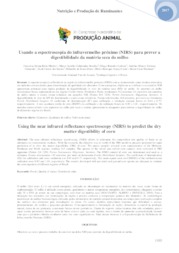Usando a espectroscopia do infravermelho próximo (NIRS) para prever a digestibilidade da matéria seca do milho.
Usando a espectroscopia do infravermelho próximo (NIRS) para prever a digestibilidade da matéria seca do milho.
Author(s): MARTINS, F. E. B.; BOMFIM, M. A. D.; GALVANI, D. B.; FERNANDES, A. M. F.; SANTOS, S. F. dos; DUTRA, M. de S.; COSTA, H. H. A.; MACHADO, H. C.
Summary: Resumo: A espectroscopia de reflectância na região do infravermelho próximo (NIRS) tem se demonstrado como técnica alternativa aos métodos convencionais para determinação da qualidade dos alimentos. Com a pesquisa, objetivou-se verificar se os modelos NIR apresentam potencial para rápida predição da digestibilidade in vitro da matéria seca (MS) do milho. As amostras de milho selecionadas foram representativas das regiões Centro-Oeste, Nordeste e Norte, totalizando 342 amostras. Os espectros das amostras do milho inteiro e moído foram coletados em aparelho NIR (Perten DA 7250, Perten Instruments, Hägersten, Sweden). A digestibilidade in vitro da MS foi determinada e usado como referência. Foram selecionadas 140 amostras, por meio da ferramenta Evenly Distributed Samples. O coeficiente de determinação (R2 ) para calibração e validação cruzada foram de 0,84 e 0,77, respectivamente. A raiz quadrada média do erro (RMSE) da calibração e da validação foram de 0,83 e 1,01, respectivamente. Os modelos desenvolvidos com espectros de milho pré-secas e moídas apresentam-se adequados para estimar a digestilidade do milho de diferentes regiões do Brasil. [Using the near infrared reflectance spectroscopy (NIRS) to predict the dry matter digestibility of corn]. Abstract: The near infrared reflectance spectroscopy (NIRS) allows to determine the composition and quality of feeds as an alternative to conventional methods. With the research, the objective was to verify if the NIR model to presents potential for rapid prediction of in vitro dry matter digestibility (DM) of corn. The maize samples selected were representative of the Midwest, Northeast and North regions, totaling 342 samples. The spectra of the whole and milled corn samples were collected in NIR apparatus (Perten DA 7250, Perten Instruments, Hägersten, Sweden). The DMD content of corn was determined and used as a reference. Foram selecionadas 140 amostras, por meio da ferramenta Evenly Distributed Samples. The coefficient of determination (R2) for calibration and cross validation was 0.84 and 0.77, respectively. The mean square error root (RMSE) of the calibration and validation were 0.83 and 1.01, respectively. The models developed with pre-dried and ground corn spectra are adequate to estimate the corn digestion of different regions of Brazil.
Publication year: 2017
Types of publication: Paper in annals and proceedings
Unit: Embrapa Goats & Sheep
Observation
Some of Embrapa's publications are published as ePub files. To read them, use or download one of the following free software options to your computer or mobile device. Android: Google Play Books; IOS: iBooks; Windows and Linux: Calibre.
Access other publications
Access the Agricultural Research Database (BDPA) to consult Embrapa's full library collection and records.
Visit Embrapa Bookstore to purchase books and other publications sold by Embrapa.

